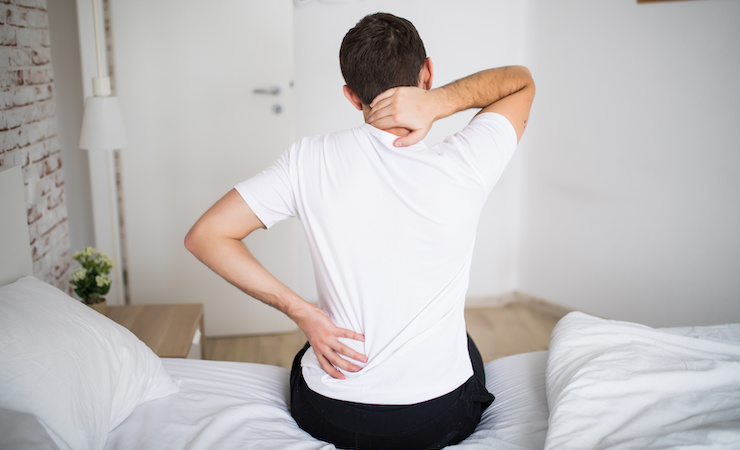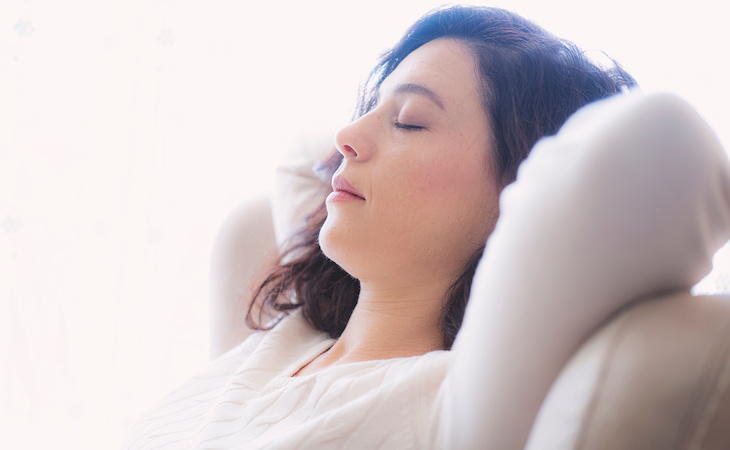When I visited an orthopedic surgeon to find out how I could get rid of the pain in my lower back, he recommended physical therapy and sleeping in a fetal position.
I’m happy to report that physical therapy—mainly stretches and exercises to strengthen muscles that support the spine—has worked wonders and eliminated the severe pain of spinal arthritis. Sleeping in the fetal position also helped relieved the pain I would feel in other sleep positions and let me get the rest I needed.
Could this sleep position be right for you too? This article will explore the pros and cons of sleeping in the fetal position and answer the most common questions about this position.
What is the fetal sleep position?
The easiest way to explain the fetal position—and the reason for its name—is it’s the position of a fetus in the mother’s womb. It involves lying on the left or right side and bringing up the knees to the chest—forming a kind of ball.
It’s important to distinguish the fetal sleep position from regular side sleeping. The National Sleep Survey previously reported that 74% of sleepers snooze on their sides.
But only certain people, in particular circumstances, are advised to consider the fetal position for their sleep time. Even then, it’s best not to make it an every-night and always thing.
Benefits of the fetal sleep position
“There are only a few conditions I can think of that could benefit from a fetal position,” says chiropractor Tom Tozer, a provider with Wisconsin-based Imperium Chiropractic. He says he would probably only suggest it as a way to get “some stress off of the spine”—precisely why my orthopedist recommended the fetal sleep position for me.
Even then, Tozer says, “I think it would be important to do something other than just resort to side sleeping or the fetal position.” Sleeping in the fetal position can help, but it alone isn’t the solution—as my own success because of physical therapy demonstrates.
Can I sleep in the fetal position if…
Again, it’s important to distinguish sleeping in the side sleep position vs. the fetal sleep position. Many more people can benefit from sleeping on their side than from sleeping in the fetal position.
Here are examples of those who can benefit from side sleeping in general and potentially sleeping occasionally in the fetal sleep position.
I have back pain
As I found, sleeping in the fetal position can provide needed pain relief by relaxing the discs of the spine. But in general, “I would not recommend fetal position if we’re trying to keep a spine healthy,” says Tozer.
But, he adds, if the goal is to get an injured or irritated spine to relax so the person can sleep, and if it’s only temporary, “then usage of a fetal position would be OK.” (These are the best and worst sleep positions for back pain.)
I’m pregnant
You may have heard that sleeping in the fetal position is good during pregnancy, particularly in the later stages. But Tozer says he’s unaware of any studies demonstrating that the fetal position is beneficial for pregnant people.
He adds, however, that side sleeping can be comfortable during pregnancy—perhaps with a pillow to support the belly—while back sleeping can put pressure on the stomach and other organs.
I have sleep apnea
Once again, distinguishing the fetal position from the regular side sleep position, sleeping on your side can help reduce the snoring that characterizes obstructive sleep apnea. It may also help prevent the blockages of your airways that cause people with apnea literally to stop breathing multiple times each night.
I have acid reflux
Instead of the fetal sleep position, Tozer recommends that people with acid reflux sleep on their left side due to the location of the stomach. This can help prevent acid reflux and allow you to rest comfortably.
When is the fetal sleep position not for you?
If you’re concerned about the health of your spine, the fetal position isn’t good for you—certainly not long-term. “A normal, healthy spine has four curves,” Tozer explains, “and when you curl into a ball, you’re putting your spine into a big ‘C.’” That can contribute toward losing the normal curve in your lower back.
FAQs
Why do I sleep in the fetal position?
You may sleep in the fetal position for one of the good reasons noted above. It’s possible you also sleep in the fetal position, even once in a while, when you find it comforting.
“It’s actually one of the most common sleeping positions, which makes sense, as this is the way you slept while you were in the womb,” says U.K.-based body language and relationship expert Annabelle Knight. “Because of this, it provides a level of comfort and brings you back to your childhood—which suggests that even though you may have a tough exterior, you hide a sensitive soul beneath.”
Is sleeping in the fetal position healthy?
It’s healthy under certain circumstances, such as when dealing with severe lower back pain, and on a limited basis. It can help relax the spine, relieve pain, and allow you to sleep. In most cases, though, sleeping in the fetal position—certainly over an extended period—can actually be harmful to your spine and contribute to poor posture.
What is the healthiest sleep position?
The general consensus among sleep experts is that sleeping on your back is best. This position evenly distributes weight along the body, minimizes pressure points, and helps keep the head, neck, and spine properly aligned.
Sleeping on the side is popular, but it can pull the spine out of alignment and strain the back. Tozer says back and side sleeping are the most recommended because “they’re going to allow the spine to be in the most neutral position of all the sleeping postures.”
It’s important to find a mattress that properly supports your body in your preferred sleep position. Check out our guide to the most comfortable mattress for your sleep style.







